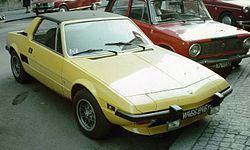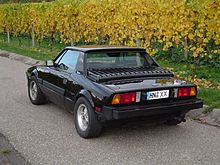Fiat X1 / 9
| Fiat | |
|---|---|
|
Fiat X1 / 9 (1972-1982)
|
|
| X1 / 9 | |
| Production period: | 1972-1988 |
| Class : | Sports car |
| Body versions : | Coupe |
| Engines: |
Petrol engines : 1.3–1.5 liters (54–63 kW) |
| Length: | 3830-3980 mm |
| Width: | 1570 mm |
| Height: | 1143-1170 mm |
| Wheelbase : | 2202 mm |
| Empty weight : | 880-980 kg |
| Previous model | Fiat 850 Spider |
| successor | ( Fiat Barchetta ) |
The Fiat X1 / 9 is a small sports car that was built by Fiat and Bertone from 1972 to 1988 . The car was designed and developed by Carozzeria Bertone .
history
The Fiat X1 / 9 is the successor to the Fiat 850 Spider , which was also designed by Bertone , and belongs to the extended type series Fiat 128, which is also shown by the type code 128AS assigned in the series at Fiat. The Autobianchi Bertone Runabout study shown at Bertone in 1969 offered a first glimpse of the new model . At the Turin Motor Show , this study was dubbed the Autobianchi so as not to take the Fiat management by surprise, but Bertone had the 128 series in mind from the start.
The Cheetah study based on VW, developed by Giugiaro on behalf of Karmann in Osnabrück, was externally similar in some details to the X1 / 9, but contrary to the legend sometimes spread in some media, it has no reference to the development history of the X1 / 9, especially since Bertone with this Study had nothing to do with. The cause of this similarity was probably on the one hand the general trend towards the "wedge" in Italy at that time, of which Bertone was a great advocate, and on the other hand the fact that Giugiaro, as his student, had certainly adopted some of these design principles in his then new company Italdesign, where the Cheetah was designed. The latter was considered as a possible successor to the VW Karmann Ghia, and at Karmann in Osnabrück the prototype was then also built on the platform of the VW Type 1 (Beetle). As a vehicle with a boxer rear engine, it had nothing in common with the X1 / 9 technically.
In September 1972 the X1 / 9 was officially presented as a member of the 128 family. A key feature of the vehicle was the mid-engine , which ensured a balanced weight distribution and neutral handling. The engines and transmissions come from this type family, as well as some other technical components such as the brake system and some parts of the front axle. The body, on the other hand, was an independent child of Bertone, in which many forms and details of the runabout could be found. It was also not atypical for Bertone at this time that many X1 / 9 mass-produced parts were used in other vehicles built by Bertone; Examples are the door handles on the Lancia Stratos or the Lamborghini Urraco.
The vehicle was designed as a "safety cabriolet". It was a coupe with a targa roof and roll bar. Apart from the Mercedes-Benz S-Class of the 116 series, the Fiat X1 / 9 is the only vehicle of its generation that was able to meet the crash requirements stipulated by the US authorities for 1975.
The range of types and engines was manageable over the entire model cycle. There are basically two series, one with 1300 cm³ and one with 1500 cm³ displacement. Both basic engines are those of the Fiat 128 engine series with an overhead camshaft . This family of engines was developed by Aurelio Lampredi, who created many large engines for Ferrari and Fiat.
The first series from 1972 to 1978 was the original variant with a 1300 cm³ engine and four-speed manual gearbox and carburetor. Depending on the year of construction, it offered between 73 and 75 hp. In the USA there were already modified versions with exhaust gas afterburning and exhaust gas recirculation, which had significantly less power, because of the stricter exhaust gas laws.
In the course of 1978, the optically and technically revised X1 / 9 FiveSpeed was built and delivered. From the same engine family it received an engine with a displacement of 1500 cc and a five-speed gearbox ("FiveSpeed"). The FiveSpeed, which was equipped with a carburettor , usually had an output of 86 hp, although there were also individual versions for special markets that had to make do with lower output due to emissions.
From 1980 a version with electronic Bosch gasoline injection (Bosch L Jetronic) and a regulated catalytic converter was built for the export market in the USA (and from 1985 for Europe). This version made 75 hp.
Facelift
Because of the declining lucrative value of the US market there were considerations in the early 1980s to discontinue the Fiat X1 / 9. The mainstays of the US business at the time were the Fiat 124 Spider, the X1 / 9 and the US versions of the Ritmo and the 131. About 75 percent of the total production of the X1 / 9 was sold to North America at the time. Bertone, who designed the car and had built the body to date, suggested that the car should continue to be offered under the brand name Bertone X1 / 9. The Fiat dealer network was used for sales. Fiat accepted this offer and agreed to continue to supply Bertone with the technical components.
From spring 1982, the practically identical car was now offered under the Bertone brand (initially with the IN special series, which referred to the tenth anniversary of the X1 / 9). In the course of the introduction of catalytic converters in Europe in the late 1980s, Bertone was one of the first manufacturers to be able to offer a vehicle with a regulated three-way catalytic converter from April 1985, as it was possible to fall back on the US version that had been built under Fiat's direction since 1980.
Over the years, Bertone gradually improved the vehicle's equipment (leather interior, air conditioning, electric windows). With the special model "Sunshine" from 1985, a variant with reduced equipment (with catalytic converter) was added to the range.
The driving performance of the Fiat X1 / 9 is inconspicuous from today's perspective. In a contemporary comparison of the 1970s and 1980s, on the other hand, the performance could definitely be classified as sporty. Apart from the manageable engine power compared to today's small sports cars, the driving behavior, especially on winding roads, can still be classified as very sporty, which is due to the mid-engine design.
At the beginning of 1988, sales ended after around 165,000 copies. Production had already been stopped in 1987. Also in 1987 the last official special model with the name Gran Finale appeared , exclusively for the British market. It was equipped with a mica metallic paintwork in blue or reddish brown, Alcantara interior, OZ wheels and carburettor engine.
Special models
The first special model was the X1 / 9 Corsa in 1975, but it never got beyond prototype status.
The first official special model in German-speaking countries was the X1 / 9 Exklusiv, which was built between 1976 and 1978. At the same time, the now very rare X1 / 9 Lido was produced especially for Switzerland, France, Belgium and Great Britain in small series (approx. 700 copies).
After Bertone took over production, the two-tone special model “IN” appeared in 1982 with an edition of around 500 vehicles. This was followed by the also two-tone special model "VS" (Versione Speciale).
In 1985 about 1000 units of the "X1 / 9 Sunshine" were built. The right-hand drive "Gran Finale" was the last special model built for Great Britain until the beginning of 1988.
Special racing models
Filipinetti X1 / 9
After the presentation of the X1 / 9 in Turin at the end of 1972, the X1 / 9 was prepared for racing under pressure from the Fiat group. The Swiss Scuderia Filipinetti , which had already been successful with the Fiat 128, was commissioned for this at the beginning of 1973 . Mike Parkes then built the Filipinetti X1 / 9, which was presented at the Geneva Motor Show in early 1973 . At that time, Gian Paolo Dallara's 16-V prototype engine was also tried out in the Filipinetti. After just one race on April 1, 1973 at the Nürburgring , the Filipinetti X1 / 9 disappeared after the sudden death of Georges Filipinetti (owner of Scuderia). The whereabouts of the Filipinetti-X1 / 9 was uncertain for over 30 years. It was then found by chance in Puerto Rico in late 2004 in relatively poor condition. After being transported to Germany, it is said to have been restored there in the following years.
X1 / 9 Abarth
At the end of 1973 the X1 / 9 Abarth was developed. This created a direct competitor to the Lancia Stratos in the Fiat-Lancia group . The Abarth X1 / 9 had a 16 V cylinder head that was mounted on a bored out 1600 cc engine block. The body was heavily modified for the requirements of rally sport. In order to supply the mid-engine with enough fresh air, a distinctive "snorkel" was attached to the bonnet. However, the idea of using the X1 / 9 Abarth in a rally ended prematurely. The Fiat group decided in favor of the 131 Abarth and the Lancia Stratos. In total, only six racing cars with the name "Prototipi" and one street version with the name "Stradale" were built. The whereabouts of these prototypes is now known.
Icsunonove Dallara
In 1975 a racing version of Group 5 of the Fiat X1 / 9 was presented at the Paris Motor Show: the Icsunonove Dallara. The car was specially equipped by Bertone with a GRP body. A special chassis and the 16 V cylinder head already tested in the Filipinetti X1 / 9 came from Dallara . Performance was improved by Dallara during the 1970s. The Dallara X1 / 9 was mainly used for hill climbs, but it was also active on circuit tracks, for example at the Leinberger Racing 1977 in Germany. The Dallara could still be seen in various races until the late 1980s.
License construction in Brazil
- Corona Dardo - 270 individual copies based on the X1 / 9, built between 1979 and 1983; High-performance Fiat engines with 1300 cm³ (53 kW / 72 PS) and 1500 cm³ (70.5 kW / 96 PS), each with Weber double carburetors, were used.
literature
- Purchase advice in Oldtimer-Markt 10/2009, p. 44ff.
- Automobil Revue , catalog number 1982 (Dardo Brazil)
Web links
- Filipinetti X1 / 9 Everything about the first X1 / 9 racing car
- Pages about the special types X1-9 Lido, Abarth and Dallara
- German-language X 1/9 Wiki
- Fiat / Bertone X1 / 9 Club Germany /
Individual evidence

